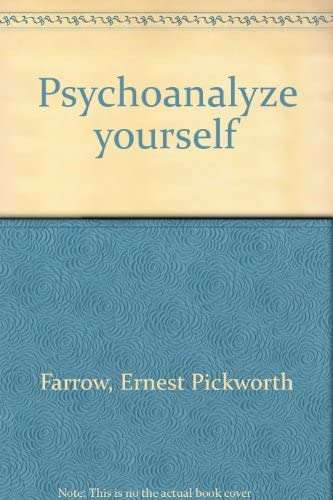Psychoanalyze Yourself
NO CHEATING! That will take all the fun out of it.
This is a very interesting test. Try it.
Have a pen and paper handy before you read any further. As soon as you read aquestion, write the answer right away.
Make sure to answer questions 1-10 before moving on…NO CHEATING!!
Read the following questions, imagining the scenes in your mind, and write downthe FIRST thing that you visualize. Do not think about the questionsexcessively.
1. You are not alone. You are walking in the woods. Who are you walkingwith?
2. You are walking in the woods. You see an animal. What kind of animal isit?
3. What interaction takes place between you and the animal?
4. You walk deeper in the woods. You enter a clearing and before you is yourdream house. Describe its size?
5. Is your dream house surrounded by a fence?
6. You enter the house. You walk to the dining area and see the dining roomtable. Describe what you see on AND around the table.
7. You exit the house through the back door. Lying in the grass is a cup.What material is the cup made of?
8. What do you do with the cup?
9. You walk to the edge of the property, where you find yourself standing atthe edge of a body of water. What type of body of water is it?
10. How will you cross the water?
This has been a relational psychology test. The answers given to the questionshave been shown to have a relevance to values and ideals that we hold in ourpersonal lives. The analysis follows:
1. The person who you are walking with is the most important person in yourlife.
2. The size of the animal is representative of your perception of the size ofyour problems.
3. The severity of the interaction you have with the animal is representative of how you deal with your problems. (passive/aggressive)
4. The size of your dream house is representative of the size of your ambitionto resolve your problems.
5. No fence is indicative of an open personality. People are welcome at alltimes. The presence of a fence indicates a closed personality. You’d preferpeople not to drop by unannounced.
6. If your answer did not include food, people, or flowers, then you aregenerally unhappy.
7. The durability of the material with which the cup is made of isrepresentative of the perceived durability of your relationship with the personnamed in number 1. For example, styrafoam, plastic, and paper are alldisposable, styrofoam, paper and glass are not durable, and metal and plasticare durable.
8. Your disposition of the cup is representative of your attitude towards theperson in number 1.
9. The size of the body of water is representative of the size of your sexualdesire.
10. How wet you get in crossing the water is indicative of the relativeimportance of your sex life.
Brought to you by http://BL.net/
View art in video
The following is a transcript of this video.
Why do so many people fail to flourish? And what can we do in our own life to ensure we do not succumb to the states of apathy, self-sabotage, and fear which abound in the lives of the mass of men? In a series of books,the 20th century psychoanalyst Karen Horney explored the idea that many people undermine their own well-being as a result of unconscious disturbances which influence their thoughts and behaviors. In this video we are going to examine Horney’s ideas on why unconscious disturbances form, and explore the possibility of attaining self-knowledge so as to free ourselves from their crippling influence.
That many people wither rather than blossom as they age was intriguing to Horney given her belief that in every individual is an innate drive to self-realization. To help explain the nature of this drive, Horney suggested that the development of a human being is analogous to that of an oak tree. Given appropriate environmental conditions, an acorn will develop into a healthy oak tree – it will flourish and fulfill its innate potential. In a similar manner, Horney posited that every individual will tend towards self-realization – provided we are not impeded by our environment. As she explains:
“You need not, and in fact cannot, teach an acorn to grow into an oak tree, but when given a chance, its intrinsic potentialities will develop. Similarly, the human individual, given a chance, tends to develop…the unique alive forces of his real self; the clarity and depth of his own feelings, thoughts, wishes, interests; the ability to tap his own resources, the strength of his will power…All this will in time enable him to find his set of values and aims in life. In short, he will grow, substantially undiverted, toward self-realization.” (Karen Horney, Neurosis and Human Growth)
Unfortunately, for many people the movement toward self-realization is disrupted due to neglect, rejection, abuse, or other forms of childhood trauma. The child subjected to this early wounding is unable to say: “My parent has personal problems which are having an effect on me”, but rather the child is only able to conclude that the world is unsafe. Hence, they become plagued by what Horney calls “basic anxiety” which initially renders them helpless and overwhelmed, but over time propels them to find ways to cope with life despite their fears. They develop what Horney calls unconscious “neurotic trends” which sculpt their personality so as to give them the semblance of safety in what is perceived to be a threatening environment. And when they emerge into adulthood these neurotic trends do not disappear, but rather they continue to influence their attitudes and behaviors and wreck havoc on their well-being. Rare is the individual who lives completely free from these unconscious relics leftover from childhood.
The type of neurotic trends which form depend upon both temperament and environmental factors. Some adapt to an unfavorable upbringing by detaching from life and other people. Others develop a neurotic need for approval and affection. Neurotic trends, however, are complex and individual and therefore defy rigid conceptualization. But when our behavior is unconsciously motivated by them we tend to develop symptoms in due time. If we are not afflicted with phobias, depression, compulsions, severe apathy, co-dependency, addictions, or extreme indecision, we may become plagued by an inner emptiness or feel as if there is a vital element missing in our life. Rather than focusing on the outward manifestation of our symptoms, however, Horney advises us to fixate on their underlying source – that being, the neurotic trends we developed as a means to cope with life.
Psychoanalysis was founded by Sigmund Freud following his discovery that his patients’ symptoms could be cured when the unconscious factors underlying them – be it repressed memories or emotions – were made conscious. Many followers of psychoanalysis, however, believed the excavation of unconscious material could only be conducted with the help of a trained therapist. But Karen Horney was one of the few 20th century psychoanalysts who thought it could be accomplished alone. She called this form of therapy self-analysis, and defined it as the “attempt to be patient and analyst at the same time”. (Karen Horney, Self-Analysis)
But Horney did not deem self-analysis as merely a possibility, rather, in many cases she thought it to be more desirable than traditional therapy. The therapist always begins as a stranger who requires months if not years of analysis to learn of the inner workings, complexities, and depths of our mind. We, on the other hand, are intimately familiar with ourselves. Given the right attitude, we can, therefore, explore and expose the elements of our unconscious wrecking havoc on our life more efficiently than a trained therapist. Furthermore, self-analysis has the added benefit that it can increase our strength and confidence to a greater degree than traditional therapy. Just as traversing a difficult mountain path on our own grants us a greater feeling of accomplishment than following a guide, so too, Horney notes,
“there is a certain extra gain in having conquered [inner] territory entirely through one’s own initiative, courage, and perseverance.” (Karen Horney, Self-Analysis)
Yet despite its benefits self-analysis does not lack obstacles – the primary of which is how difficult self-knowledge is to attain. The curative role of self-knowledge has been recognized for thousands of years – in the West most notably in the philosophy of Socrates and Plato and in the aphorism “know thyself” inscribed on the ancient Greek temple of Apollo at Delphi. But the ancient Greeks, Horney points out, believed the attainment of self-knowledge to be far easier than we do today. Exploring our inner depths, we now know, is no easy matter but is rather akin to an adventure into an unknown territory full of surprises and potential dangers. In his book The Dawn of Day, Nietzsche echoes this sentiment by describing the vast gulf which separates the ancient Greek conception of the mind from the modern.
“…how simple were the Greeks in the idea which they formed of themselves!” he writes. “How far we surpass them in the knowledge of man! Again, how full of labyrinths would our souls and our conceptions of our souls appear in comparison with theirs! If we had to venture upon an architecture after the style of our own souls—(we are too cowardly for that!)—a labyrinth would have to be our model.” (Nietzsche, The Dawn of Day)
Another obstacle which confronts us in self-analysis is fear. Many avoid descending into their depths in the apprehension that they may stumble upon a deeply disturbing insight, or worse, become lost and confused in their inner labyrinth, unable to find their way out. But Horney dismisses these fears as unfounded. Uncovering an alarming truth or repressed memory, she notes, is not just painful but also liberating. And furthermore, if we come upon a disturbing insight, Horney explains that it usually implies we are strong enough to endure and work through it.
“The mere fact that he has gone that far indicates that his will to come to grips with himself is strong enough to prevent him from being crushed.” (Karen Horney, Self-Analysis)
But even given its difficulties, self-analysis can be highly effective and beneficial – provided we have a strong incentive to grow. Horney in fact deems our motivation to overcome our problems as the primary determinant in whether self-analysis is successful or not.
“Experience…shows beyond any doubt that patients can develop an amazing faculty of keen self-observation if they are bent on understanding their own problems.” (Karen Horney, Self-Analysis)
Therefore, if we find ourselves overly passive, deeply unhappy, or saddled with symptoms we can’t seem to shake, we could try to kindle a burning desire to find the key to our problems and set aside time for self-reflection and self-observation. Shining a light on the hidden corners of our mind can be uncomfortable and painful, but such a task may be necessary not only to free ourselves from the neurotic trends we developed in childhood, but also to restore the innate growth forces within and keep us steadfast on the path of self-realization -continuously growing, in the words of Horney, “from acorn to oak tree.” (Karen Horney)
“Self-knowledge is not an aim in itself, but a means of liberating the forces of spontaneous growth. In this sense, to work at ourselves becomes not only the prime moral obligation, but at the same time, in a very real sense, the prime moral privilege. To the extent that we take our growth seriously, it will be because of our own desire to do so.” (Karen Horney, Neurosis and Human Growth)
Further Readings



